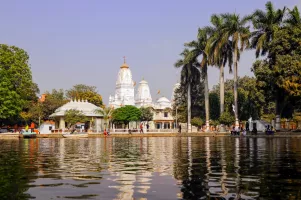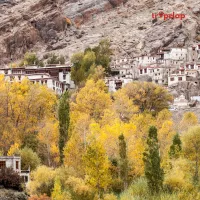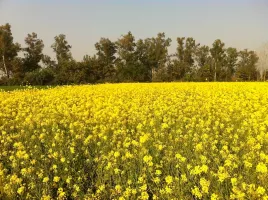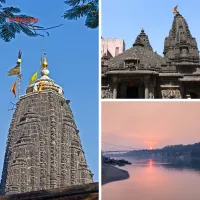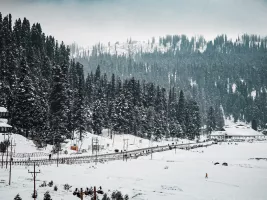Kanwar Yatra 2024 - Significance & Important Routes
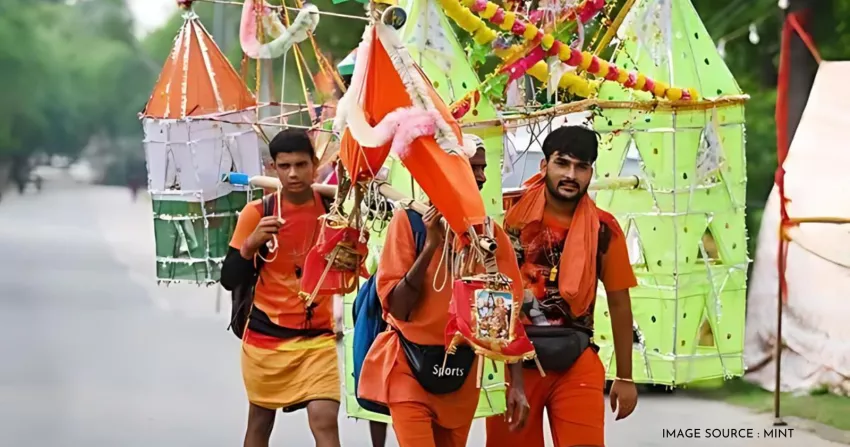
Kanwar Yatra, a major Hindu pilgrimage, sees millions of devotees, known as Kanwariyas, undertake a sacred journey to collect water from the Ganges River and offer it to Lord Shiva. This ritual, deeply rooted in tradition, is a testament to the unwavering faith and dedication of the pilgrims. In 2024, the Yatra is expected to draw even larger crowds, making it essential to understand its significance, routes, and guidelines.
Significance of Kanwar Yatra
Kanwar Yatra holds immense religious importance in Hinduism, particularly for devotees of Lord Shiva. The journey symbolizes devotion, penance, and the quest for spiritual purification. Kanwariyas believe that offering the holy Ganges water to Shiva's temples will cleanse them of sins and bring blessings.
Historical Background
The tradition of Kanwar Yatra dates back centuries and is rooted in ancient scriptures and legends. It is believed that the practice originated when Lord Shiva drank the poison that emerged during the churning of the ocean (Samudra Manthan) to save the universe. To cool his throat, devotees began offering him holy water.
Key Rituals and Practices of Kanwar Yatra 2024
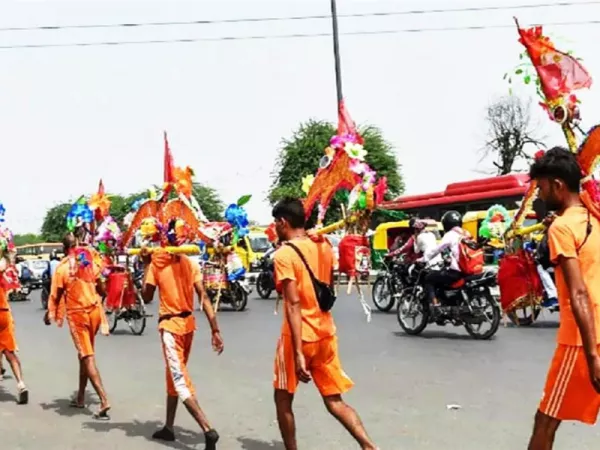 View Gallery - 2
View Gallery - 2 The Kanwar Yatra is marked by several significant rituals and practices that demonstrate the devotion and discipline of the participants, known as Kanwariyas. Here are the key aspects:
Fasting and Devotion
- Fasting: Many Kanwariyas observe fasts during the Yatra, refraining from consuming certain foods and sometimes abstaining from eating altogether during the day.
- Chanting Hymns: Continuous chanting of "Bam Bam Bhole" or other hymns dedicated to Lord Shiva is a common practice, filling the atmosphere with spiritual fervor.
Carrying the Kanwar
- The Kanwar: Pilgrims carry a decorated bamboo pole with pots (Kanwar) on either side, balanced on their shoulders. These pots are filled with holy water from the Ganges River.
- Barefoot Journey: Many devotees undertake the Yatra barefoot, symbolizing humility and dedication.
Holy Water Collection
- Ganges Water: The primary ritual involves collecting water from the Ganges River, particularly from places like Haridwar, Gaumukh, Gangotri, and Varanasi.
- Sacred Offerings: The collected water is offered at Shiva temples, especially the Jyotirlingas, with the belief that this act will bring blessings and purification.
Adherence to Codes of Conduct
- Purity and Discipline: Pilgrims maintain physical and mental purity, avoiding any acts that might be considered impure or disrespectful.
- Respectful Behavior: Maintaining decorum and respectful behavior towards fellow pilgrims and the environment is emphasized.
Physical and Spiritual Challenges
- Long Distances: The journey often covers long distances, requiring physical endurance and mental resilience.
- Community Support: Pilgrims often travel in groups, supporting each other through the challenges of the journey.
Environmental Responsibility
- Cleanliness Drives: Participants are encouraged to engage in cleanliness drives, ensuring that the routes and riverbanks remain clean and free of litter.
- Avoiding Plastics: Using biodegradable materials and minimizing plastic use is promoted to protect the environment.
Health Precautions
- Medical Check-ups: Prior to the Yatra, devotees are advised to undergo medical check-ups to ensure they are fit for the journey.
- Carrying Essentials: A basic medical kit, adequate water, and nutritious food are essential for maintaining health during the pilgrimage.
Cultural Celebrations
- Festive Atmosphere: The Yatra is not only a spiritual journey but also a cultural celebration, with music, dances, and community meals enhancing the festive spirit.
Spiritual Reflection
- Introspection and Meditation: Many Kanwariyas use the time for introspection and meditation, seeking a deeper connection with Lord Shiva and spiritual enlightenment.
These rituals and practices form the essence of the Kanwar Yatra, reflecting the deep-rooted faith, discipline, and community spirit of the pilgrims.
Major Routes of Kanwar Yatra 2024
The Kanwar Yatra features several major routes that devotees undertake to collect holy water from the Ganges River and other significant sources. Here are some of the most prominent routes for Kanwar Yatra 2024:
Haridwar Route
- Starting Point: Har Ki Pauri in Haridwar.
- Significance: One of the most popular routes, known for its accessibility and the spiritual significance of Haridwar.
Gaumukh Route
- Starting Point: Gaumukh Glacier.
- Significance: Involves a challenging trek to the source of the Ganges, appealing to those seeking a more rigorous spiritual journey.
Gangotri Route
- Starting Point: Gangotri Glacier.
- Significance: Pilgrims travel to the Gangotri Glacier, one of the primary sources of the Ganges, known for its pristine and sacred waters.
Rishikesh Route
- Starting Point: Triveni Ghat in Rishikesh.
- Significance: Combines the spiritual atmosphere of Rishikesh with the tradition of the Kanwar Yatra, offering a serene pilgrimage experience.
Varanasi Route
- Starting Point: Various ghats along the Ganges in Varanasi.
- Significance: Known for the spiritual and historical importance of Varanasi, one of Hinduism's holiest cities.
Allahabad Route
- Starting Point: Sangam in Prayagraj (Allahabad).
- Significance: The confluence of the Ganges, Yamuna, and the mythical Saraswati rivers, making it a significant spiritual destination.
Delhi Route
- Starting Point: Yamuna banks in Delhi.
- Significance: Although not directly from the Ganges, many devotees from Delhi start their journey here and travel to collect Ganges water.
Dehradun Route
- Starting Point: Various points in Dehradun.
- Significance: Accessible for pilgrims from the nearby regions, offering a blend of urban and spiritual experiences.
Bareilly Route
- Starting Point: River Ramganga in Bareilly.
- Significance: A regional route that is significant for local devotees and includes various small-scale pilgrimages.
Preparation and Planning
Planning for the Kanwar Yatra requires careful preparation. Pilgrims need to ensure they are physically fit, have the necessary supplies, and are aware of the routes and guidelines. Medical check-ups and vaccinations are also recommended to ensure a safe journey.
Health and Safety Guidelines
- Stay Hydrated: Drink plenty of water to avoid dehydration.
- Proper Footwear: Wear comfortable and supportive footwear to prevent injuries.
- Medical Kit: Carry a basic medical kit with essential medicines.
- Follow COVID-19 Protoco
Role of Authorities and NGOs
Local authorities and NGOs play a crucial role in ensuring the smooth conduct of the Yatra. They provide medical aid, security, and logistical support to the pilgrims. Additionally, they organize awareness campaigns on environmental conservation and safety measures.
Challenges and Issues
Despite the spiritual significance, the Kanwar Yatra faces challenges such as overcrowding, traffic congestion, and environmental degradation. Addressing these issues requires coordinated efforts from authorities, NGOs, and the pilgrims themselves.
Conclusion

Akshita Gera
Frequenty Asked Questions
1. Why is the Kanwar Yatra significant?
2. What are the major routes of the Kanwar Yatra 2024?
3. What role do authorities play in the Kanwar Yatra?
4. when is kawad yatra 2024?
5. why was kavad yatra started?
6. how many types of kawad yatra?
Kavad Yatra includes several types:
- Traditional Kavad Yatra: Pilgrims carry water from sacred rivers to Shiva temples, mostly in North India.
- Kanwar Yatra: A major pilgrimage during the Sawan month, where devotees transport Ganga water to Shiva temples.
- Mahashivratri Kavad Yatra: Undertaken during the Mahashivratri festival, with water carried to temples in celebration.
- Ganga Dussehra Kavad Yatra: Occurs during Ganga Dussehra, marking the descent of the Ganges.
7. what is dak kawad yatra?

Tell us about your trip

Get Custom quotes from top agents.

Choose the package you like
• Kollam • Murshidabad • Gurgaon • Surat Thani • Unakoti • Ananthagiri • Devbagh • Darang • Anjaw • Ninh Binh • Khilanmarg • Granada • Seremban • Mon • Hoa Binh • Auroville • Pattadakal • Nagarjunakonda • Dispur • Karnaprayag • Champhai • Dehradun • Maravanthe • Lachen • Mirik • Kohima • Oxford • Samut Prakan • Koh Poda • Nahan • Yinchuan • Baripada • Bau • Halebidu • Champawat • Kurnool • Trivandrum • Moscow • Lansdowne • Andaman • Bir Billing • Pai • Karkala • Chail • Tioman Island • Gurez Valley • Darjeeling • Chikhaldara • Sydney • Kabini
Kashmir Tour Packages Andaman Tour Packages Kerala Tour Packages Shimla Tour Packages Manali Tour Packages Sikkim Tour Packages Uttarakhand Tour Packages Rajasthan Tour Packages Chardham Tour Packages Gujarat Tour Packages Rameswaram Tour Packages Gangtok Tour Packages Goa Tour Packages Jaipur Tour Packages Ooty Tour Packages Jim Corbett Tour Packages Mussoorie Tour Packages Kanyakumari Tour Packages Meghalaya Tour Packages Ladakh Tour Packages
Dubai Tour Packages Bali Tour Packages Singapore Tour Packages Thailand Tour Packages Maldives Tour Packages Bhutan Tour Packages Vietnam Tour Packages Mauritius Tour Packages Nepal Tour Packages Europe Tour Packages Sri lanka Tour Packages Turkey Tour Packages Malaysia Tour Packages Azerbaijan Tour Packages


 May
May June
June July
July August
August September
September October
October November
November December
December January
January February
February March
March April
April


